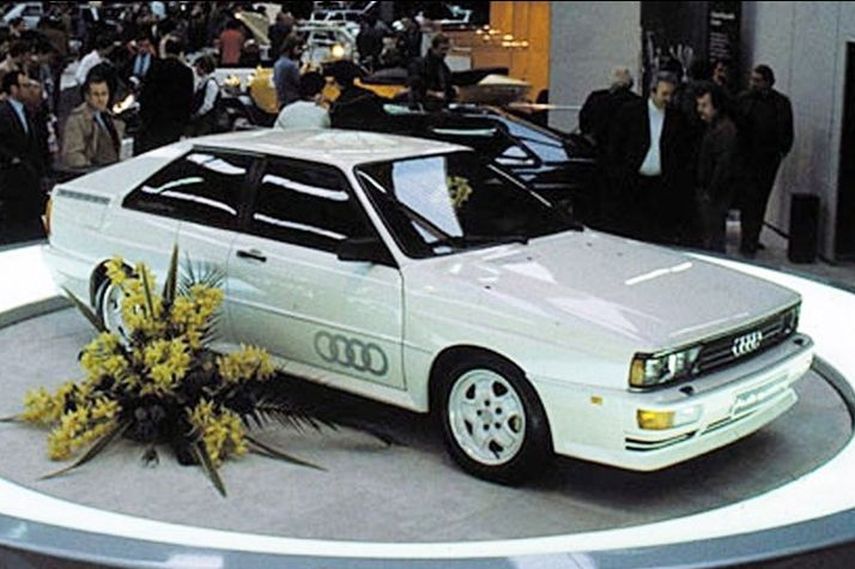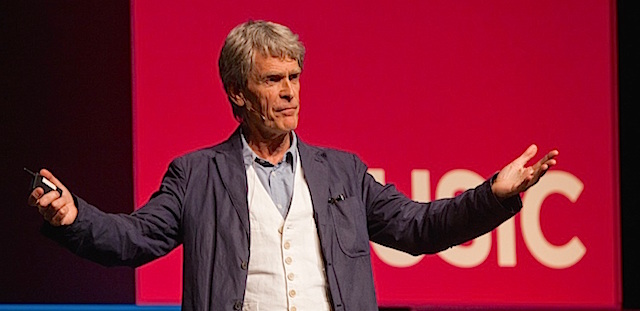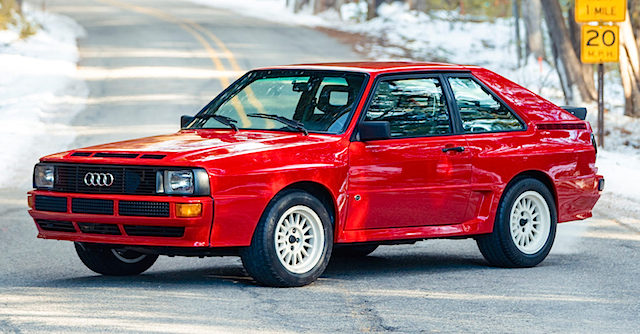
Audi’s marketing slogan ‘Vorsprung durch Technik’ is 50 years old this year – but it didn’t find its way into mainstream advertising until the early 1980s.
British advertising doyen Sir John Hegarty (below) spotted the line in 1982 on a visit to the Audi factory in Germany. He had just founded the agency Bartle Bogle Hegarty (BBH) and was looking for a catchline to sell Audis in Britain.
Despite scepticism that a German phrase with such a bland English translation as “advancement through technology” would work, Hegarty went with his gut feeling.
He saw it as a means of emphasising German quality and engineering integrity. The phrase that first appeared in Britain in 1983 is now one of the most famous and long-running in advertising.
It is one of few “foreign” phrases firmly ingrained in popular culture. It first cropped up in television show Only Fools and Horses in the 1980s, when Del Boy comforts a German girl about to give birth. It can be heard in tracks by Blur and U2 and in films such as Lock, Stock and Two Smoking Barrels.
It made the link between the Audi quattro and its permanent all-wheel-drive system but is rooted in earlier technical innovations in the Audi-NSU range. Audi in 2010 won a seven-year legal battle to take full control of the phrase as a trademark.
Porsche family member Ferdinand Piech (1937-2019) is said to have coined Vorsprung durch Technik in engineering circles in the 1960s. Piech – grandson of Ferdinand Porsche and later in life the chairman of the supervisory board of Audi parent the Volkswagen Group – joined Audi in 1972 as chief technical director. He arrived a year after Audi had adopted the slogan to describe its line-up of NSU models.
Piech, a mechanical engineer who worked for Porsche from 1963 to 1971, was in charge of a project to develop an all-wheel-drive model.
He started with the Audi 80 and 100 sedans and then, in 1977, began working on what would become the Audi Quattro, the car perhaps most synonymous with Vorsprung durch Technik.
Piech and his engineers knew that a car that distributes engine power to all four wheels was capable of withstanding higher lateral forces than one with rear- or front-wheel drive. Therefore its traction and cornering power were superior.
The engine Piech (above) built for the prototype Audi was a turbocharged five-cylinder in-line unit. He got the idea for such an engine after working on a turbodiesel five-cylinder unit for Mercedes-Benz early in his career.
An in-line six-cylinder engine was too long for the Quattro prototype, which was based on a two-door VW Santana/Passat. So Piech built a five-cylinder petrol unit, using the earlier Mercedes-Benz diesel as a template.
Piech’s development work centred around the question: How much performance can front-wheel drive develop? It consumed engineers during test drives in the snow in Sweden in 1976-77.
The camouflaged Audi prototypes with their 125kW five-cylinder engines put in a worthy performance. But they were left standing when pitted against VW’s 55kW Iltis military (below) off-road vehicle.
The solution was obvious: a sporty Audi car with permanent all-wheel drive and plenty of engine power. The project got off the ground in the early part of 1977 as “Development Order 262”.
It was masterminded by technical director Piech, project manager Walter Treser, chassis chief Jorg Bensinger and codenamed “A1”.
The prototype was a modified first-generation Audi 80 coupe with a slightly longer wheelbase and a five-cylinder turbocharged engine. The rear suspension was a second McPherson front suspension layout, rotated through 180 degrees.
In January 1978, trials began in deep snow in Austria. The prototype quickly showed how effective it was. But there was a hitch. The wife of VW development director Ernst Fiala had been driving another A1 prototype in city traffic in Vienna and complained that the car felt “tense” on tight bends: “The car ‘hops’,” she said.
On bends, the front wheels took a slightly larger arc than the rear wheels, because the A1’s axles were rigidly connected. The wheels needed to rotate faster.
Audi’s developers focused on two objectives: the all-wheel drive was to be permanent, and it had to function without a separate transfer case and second propshaft at the front. What followed was the “eureka” moment, perhaps the best illustration of Vorsprung durch Technik.
Audi’s transmission design chief Franz Tengler hit upon an idea as simple as it was practical: a 26.3cm long, hollow-drilled secondary shaft in the transmission, through which the power flowed in two directions.
 From its rear end, the shaft drove the cage of the manually lockable centre differential. The differential transmitted 50 per cent of the power via the propshaft to the rear axle, which had its own differential lock.
From its rear end, the shaft drove the cage of the manually lockable centre differential. The differential transmitted 50 per cent of the power via the propshaft to the rear axle, which had its own differential lock.
The other half of the drive torque was transferred to the front axle’s differential along an output shaft rotating inside the hollow secondary shaft. The hollow shaft permitted all-wheel drive that was virtually tension-free, light, compact and efficient.
The vital breakthrough was that the Quattro principle was no longer merely suitable for slow all-terrain vehicles and trucks but also for fast passenger cars – and furthermore for volume-produced models.
All that remained was the name. One suggestion was “Carat”, an acronym of the German for “Coupe All-Wheel Drive Turbo.” Project manager Treser came up with “Quattro”.
Said the then design chief Hartmut Warku of the name: “We wanted to symbolise a car that stands firmly on the ground. It was meant to put the emphasis on what it was capable of doing, not on what it looked like.”
Audi unveiled the Quattro (above) at the 1980 Geneva motor show. The white two-door stood on an elevated turntable. It weighed 1300kg.
Its 2.1-litre five-cylinder engine delivered 147kW and 285Nm of torque, helping it to sprint from zero to 100km/h in just over seven seconds and on to a top speed of 220km/h.
Production of the Quattro began at Ingolstadt at the end of 1980. Audi had initially planned to build only 400 units to enable the car to obtain homologation for the World Rally Championship.
But the revolutionary drive concept and its dynamic performance captivated the public from the very first day, and Audi had difficulty keeping up with demand. That’s about when Vorsprung durch Technik really hit the headlines.
In 1984 the Sport Quattro (above), with its shorter overall length and wheelbase, appeared as the homologation model of the new rally car. Its lighter materials reduced overall weight, and its new four-valve turbocharged engine with an aluminium engine block delivered 225kW.
Over time Audi improved the car inside and out. The most important technical change came in 1987. The engine had been bumped up to 2.2 litres but the Quattro now featured the Torsen differential. The worm gear replaced the manual differential lock. The name Torsen was a contraction of the two words torque and sensing.
The transmission distributed power continuously but instantly diverted up to 75 per cent of torque to whichever pair of wheels achieved better grip. Thanks to the Torsen differential, which only locks up under load, the anti-lock brake system remained permanently available.
When production ended in May 1991, Audi had built 11,452 Quattros, 224 of which were Sport versions. These days the car that will take Audi into 51 years of Vorsprung durch Technik is the electric e-tron GT, pictured at top of page.




